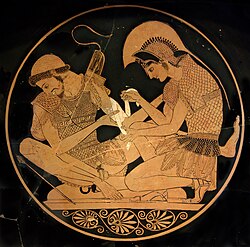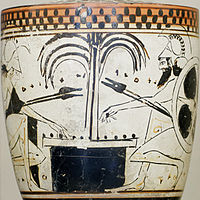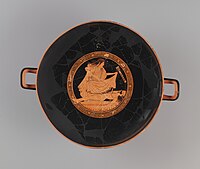Ajax the Great
| Ajax the Great | |
|---|---|
Prince of Salamis | |
 | |
| Abode | Phthia |
| Personal information | |
| Parents | Telamon and Periboea |
| Siblings | Teucer, Trambelus, Telamon |
| Consort | Tecmessa |
| Offspring | Eurysaces, Philaeus |
| Trojan War |
|---|
 |
Ajax (
Family
Ajax is the son of Telamon, who was the son of Aeacus and grandson of Zeus, and his first wife Periboea. By Telamon he is also the elder half-brother of Teucer. Through his uncle Peleus (Telamon's brother), he is the cousin of Achilles.
The etymology of his given name is uncertain. By folk etymology his name was said to come from the root of aiazō αἰάζω "to lament", translating to "one who laments; mourner". Hesiod provided a different folk etymology in a story in his "The Great Eoiae", where Ajax receives his name when Heracles prays to Zeus that a son might be born to Telemon and Eriboea: Zeus sends an eagle (aetos αετός) as a sign, and Heracles then bids the parents call their son Ajax after the eagle.[4]
Many illustrious
Mythology
Description
In the account of Dares the Phrygian, Ajax was illustrated as ". . .powerful. His voice was clear, his hair black and curly. He was perfectly single-minded and unrelenting in the onslaught of battle."[6] Meanwhile, In Homer's Iliad he is described as of great stature, colossal frame, and strongest of all the Achaeans. Known as the "bulwark of the Achaeans",[7] he was trained by the centaur Chiron (who had trained Ajax's father Telamon and Achilles' father Peleus and later died of an accidental wound inflicted by Heracles, whom he was training at the same time as Achilles). He was described as fearless, strong, and powerful but also with a very high level of combat intelligence. Ajax commands his army wielding a huge shield made of seven cowhides with a layer of bronze. Most notably, Ajax is not wounded in any of the battles described in the Iliad, and he is the only principal character on either side who does not receive substantial assistance from any of the gods (except for Agamemnon) who take part in the battles, although, in book 13, Poseidon strikes Ajax with his staff, renewing his strength. Unlike Diomedes, Agamemnon, and Achilles, Ajax appears as a mainly defensive warrior, instrumental in the defense of the Greek camp and ships and that of Patroclus' body. When the Trojans are on the offensive, he is often seen covering the retreat of the Achaeans. Significantly, while one of the deadliest heroes in the whole poem, Ajax has no aristeia depicting him on the offensive.

Trojan War
In the Iliad, Ajax is notable for his abundant strength and courage, seen particularly in two fights with Hector. In Book 7, Ajax is chosen by lot to meet Hector in a duel which lasts most of a whole day. Ajax at first gets the better of the encounter, wounding Hector with his spear and knocking him down with a large stone,[8] but Hector battles on until the heralds, acting at the direction of Zeus, call a draw, with the two combatants exchanging gifts, Ajax giving Hector a purple sash and Hector giving Ajax his sharp sword.
The second fight between Ajax and Hector occurs when the latter breaks into the Mycenaean camp, and battles with the Greeks among the ships. In Book 14, Ajax throws a giant rock at Hector which almost kills him.
Ajax often fought in tandem with his brother Teucer, known for his skill with the bow. Ajax would wield his magnificent shield, as Teucer stood behind picking off enemy Trojans.
Achilles was absent during these encounters because of his feud with Agamemnon. In Book 9, Agamemnon and the other Mycenaean chiefs send Ajax, Odysseus and Phoenix to the tent of Achilles in an attempt to reconcile with the great warrior and induce him to return to the fight. Although Ajax speaks earnestly and is well received, he does not succeed in convincing Achilles.
When Patroclus is killed, Hector tries to steal his body. Ajax, assisted by

Death


As the Iliad comes to a close, Ajax and the majority of other Greek warriors are alive and well. When Achilles dies, killed by Paris (with help from Apollo), Ajax and Odysseus are the heroes who fight against the Trojans to get the body and bury it with his companion, Patroclus.[11] Ajax, with his great shield and spear, manages to recover the body and carry it to the ships, while Odysseus fights off the Trojans.[12] After the burial, each claims Achilles' magical armor, which had been forged on Mount Olympus by the smith-god Hephaestus, for himself as recognition for his heroic efforts. A competition is held to determine who deserves the armor. Ajax argues that because of his strength and the fighting he has done for the Greeks, including saving the ships from Hector, and driving him off with a massive rock, he deserves the armor.[13] However, Odysseus proves to be more eloquent, and with the aid of Athena, the council gives him the armor. Ajax, distraught by this result and "conquered by his own grief", plunges his sword into his own chest, killing himself.[14] In the Little Iliad, Ajax goes mad with rage at Odysseus' victory and slaughters the cattle of the Greeks. After returning to his senses, he kills himself out of shame.[15] The
In
Ajax's half-brother Teucer stood trial before his father for not bringing Ajax's body or famous weapons back. Teucer was acquitted for responsibility but found guilty of negligence. He was disowned by his father and was not allowed to return to his home, the island of Salamis off the coast of Athens.
Homer is somewhat vague about the precise manner of Ajax's death but does ascribe it to his loss in the dispute over Achilles' armor; when Odysseus visits Hades, he begs the soul of Ajax to speak to him, but Ajax, still resentful over the old quarrel, refuses and descends silently back into Erebus.
Like Achilles, he is represented (although not by Homer) as living after his death on the
Gallery
-
Achilles and Ajax Playing a Game. Black-figure vase painting by Exekias, ca. 540 BCE. Currently in the Vatican Museum.
-
Suicide of Ajax. Black-figure vase painting by Exekias, ca. 540 BCE. Currently in the Château-musée de Boulogne-sur-Mer in France.
-
The suicide of Ajax. Etruscan red-figured calyx-krater, ca. 400–350 BC. Currently in British Museum.
-
Ajax battling Hector, engraving by John Flaxman, 1795
-
A red-figure kylix with a depiction of the suicide of Ajax, attributed to the Brygos Painter, ca. 490-480 BCE. Currently in the Getty Museum collection.
Palace
In 2001, Yannos Lolos began excavating a Mycenaean palace near the village of Kanakia on the island of Salamis which he theorized to be the home of the mythological Aiacid dynasty. The multi-story structure covers 750 m2 (8,100 sq ft) and had perhaps 30 rooms. The palace appears to have been abandoned at the height of the Mycenaean civilization, roughly the same time the Trojan War may have occurred.[23][24]
See also
- Corpus vasorum antiquorum
- List of suicides in fiction
- Troy VII
Notes
- ^ Inscription on the so-called Eurytios Krater, a Corinthian black-figured column-krater dated c. 600 BC, using the Corinthian iota shaped like Σ.
Notes
- ISBN 978-0-674-96785-4.
- ^ "Salamis The Island" Archived 2009-02-22 at the Wayback Machine Salamis The Island – Salamina Municipality – Greek Island
- ISBN 1-57607-094-8.
- ISBN 978-0-674-99721-9.
- ISBN 9782372971621
- ^ Dares Phrygius, History of the Fall of Troy 13
- ^ Homer, Iliad 6.5.
- ^ Iliad, 7.268–272.
- ^ Iliad, 14.408–417.
- Fabulae 114.
- ^ Homer, Odyssey.
- ^ Arctinus Miletus, "Aethiopis"
- ^ Ovid, Metamorphoses, translated by Rolfe Humphries (Indianapolis: Indiana University, 1955), Book XIII, pp. 305–309
- ^ Metamorphoses, trans. Humphries, p. 318
- ^ Lesches of Mitylene, "The Little Iliad (Ilias Mikra)"
- ^ "The Belvedere Torso; Cat. 1192". Vatican Museums. Retrieved 29 January 2015.
- ^ Iliad, 7.303
- ^ Pausanias 1.35.4
- ^ a b One or more of the preceding sentences incorporates text from a publication now in the public domain: Chisholm, Hugh, ed. (1911). "Ajax". Encyclopædia Britannica. Vol. 1 (11th ed.). Cambridge University Press. p. 452.
- ^ Pausanias, Description of Greece iii. 19. § 13
- ^ Pausanias 1.35
- ^ Homer, Iliad 2.557–258.
- ^ Carr, John (2006-03-28). "Palace of Homers hero rises out of the myths". The Times. London. Retrieved 1 April 2021.
- ^ Paphitis, Nicohlas (30 March 2006). "Archeologist links Palace to Legendary Ajax". NBC News. Athens. Retrieved 1 April 2021.
References
- Homer. Iliad, 7.181–312.
- Homer, Odyssey 11.543–67.
- Bibliotheca. Epitome III, 11-V, 7.
- ISBN 978-0143106715
- Graves, Robert, The Greek Myths: The Complete and Definitive Edition. Penguin Books Limited. 2017. ISBN 978-0-241-98338-6
- Ovid. Metamorphoses 12.620–13.398.
- Friedrich Schiller, Das Siegerfest.
- Pindar's Nemeans, 7, 8; Isthmian 4
- ISBN 978-0-674-96785-4
External links
- A translation of the debate and Ajax's death. http://classics.mit.edu/Ovid/metam.13.thirteenth.html
- Paphitis, Nicholas (2006-03-30). "Archaeologist links palace to legendary Ajax". NBC News. Retrieved 2006-03-31.









